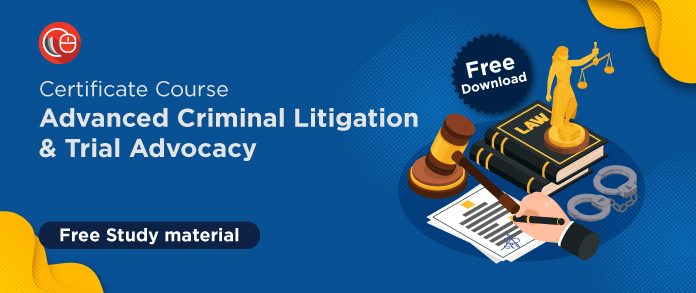This article has been authored by Bhavika Mittal, who is pursuing BA LLB at Shri Navalamal Firodia Law College, Pune. This article attempts to give a detailed account of the punishment provided by Section 323 of the Indian Penal Code, 1860.
It has been published by Rachit Garg.
Table of Contents
Introduction
Chapter XVI, titled “Of Offences Affecting The Human Body” of the Indian Penal Code, 1860, is said to be the heart of substantive criminal law. From the title, it can be deduced that the chapter ensures preserving and protecting the right to life and liberty as provided under Article 21 of the Constitution. It is the largest chapter of the Code, consisting of eighty-eight sections. These sections, in totality, cover all the aspects affecting human life.
One such non-fatal offence is hurt. It is not a fatal offence because of its non-severe nature and the negligible probability of affecting human life. Section 319 defines the offence of hurt by providing qualifications for the same. The punishment for voluntarily causing hurt is provided under Section 323 IPC. To convict an accused, hurt must be voluntarily caused by fulfilling the requirements mentioned under Section 321.
Hurt defined
The framers of the Code laid down four categories of physical assault, hurt being one of them. In layman’s language, “hurt” is when one person causes pain or injury to another. Such acts which affect humans are defined and consequently punished by the Indian Penal Code. Section 319 of the Code defines the offence of hurt.
Bodily pain
The criteria restrict itself to physical suffering only; mental and emotional pain are out of the purview of this section. Here, causing bodily pain is a requirement irrespective of the means employed, directly or indirectly. Additionally, the duration of pain doesn’t matter.
Illustration: A gives alarming news to B. Here, pain may be caused to B, but A is not liable for causing hurt.
Illustration: A, a person beats B with a stick. Here, A is liable for causing hurt to B.
In Sailendra Nath Hati v. Aswini Mukherji, 1987, the petitioner in the instant case was found guilty of hurt under Section 323 IPC by the Calcutta High Court. The Petitioner slapped the respondent, resulting in the respondent falling on the road and kicked her on the waist.
Disease
The person communicating a particular disease to another would be guilty of causing hurt. The Code does not define “disease”, but in a general sense, disease means impairment of a normal state, which affects the performance of vital functions. Regarding the transmission of sexual diseases like syphilis, etc., the judiciary’s views conflict.
Illustration: A, a person suffering from a contagious disease deliberately comes in contact with B. Here, A is guilty of causing hurt.
Infirmity
It is the inability of an organ to function normally, be it permanently or temporarily. It also includes temporary mental impairment, hysteria, or terror.
In Anis Beg v. Emperor, 1923, a girl and her family members, upon consumption of sweets, were seized by the symptoms of datura poisoning. The girl had entered delirium and was at risk of falling into a coma. The boy distributed the sweets upon persuasion by the appellant. The appellant was held guilty of causing hurt. Concludingly, neither of the persons who consumed the sweet died.
But there are instances where the accused is held guilty of hurt even though death has been caused, but only when there was neither intention nor likeliness to cause death.
For instance, in Marcelino Fernandes and others v. State, 1970, the appellants and four others beat up a man for selling a fake ring. Consequently, the victim died after three hours. The court held that the accused are not punishable under Section 304 IPC but under Section 323 IPC. The court took this decision because there was no sufficient proof of intent to kill or cause such bodily injuries, which likely caused death.
Voluntarily causing hurt
Section 321 IPC defines voluntarily causing hurt as whoever does an act:
- with the intention to hurt, or
- with the knowledge to likely cause hurt, and
- does cause hurt to another.
Simply put, voluntarily causing hurt is causing hurt with intention or knowledge. Thus, either the ingredient of intention or of knowledge must essentially be present to constitute an offence under the section.
In Dalpati Majhi v. State, 1981, the victim was using an aggressive tone, which created disturbance. The accused arrived at the scene on hearing such voices and attempted to take the victim away by holding his hands. In removing the victim from the place, the victim fell and couldn’t get up. Consequently, it was known that the victim was in a drunken state, and the accuser moved him away with the intention of restoring peace. Therefore, the Orissa High Court concluded that it could be inferred that there was no intention or knowledge on the part of the petitioner. Thus, the petitioner was acquitted of the charges under Section 321 IPC.
Classification of offence
Voluntarily causing hurt being a non-cognizable offence, is bailable and compoundable at the court’s discretion. Additionally, it is triable by any Magistrate.
Those acts where there is an intention of causing hurt to one person but is caused to another
Section 321 IPC covers all those acts where another party is hurt in the course of causing hurt to the intended person. In Radhey v. State, 1969, the victim had allegedly concealed the appellant’s mother in his house, thus, establishing the attacker’s intention. The accused and two other persons had attacked the victim with lathis resulting in the victim’s death. The accusers were held guilty of culpable homicide not amounting to murder. Further, three months of imprisonment were imposed under Section 323 IPC for causing hurt to three other persons who had intervened in the fight and received lathi blows. Here, even though there was no intention or knowledge to cause hurt to the interveners, the accuser was held guilty.
The acts which fall under Section 321 IPC are punishable under Section 323 IPC.
Essentials of Section 323 IPC
This is a general section for the punishment of voluntarily causing simple hurt. To convict a person under Section 323 IPC, it is necessary to test whether the hurt caused is,
- firstly, voluntary in nature, and
- secondly, such hurt should not be a consequence of grave and sudden provocation. The section explicitly states that Section 334 IPC, which talks about voluntarily causing hurt due to provocation, is an exception to it.
Section 334 IPC
The section prescribes punishment for voluntarily causing hurt on grave and sudden provocation. The section is viewed as the controller to Section 323 IPC as pronounced by the Allahabad High Court in Emperor v. Yussaif Hussain, 1918, where two men got into a fight, and the end of the quarrel resulted in the victim bleeding profusely. The accused was convicted under Section 334 and sentenced to pay Rs. 100.
Meaning of grave and sudden provocation
The interpretation of grave and sudden provocation under Section 323 IPC is said to resemble the meaning of Exception 1 to Section 300 IPC. It means, briefly, that the accused must be deprived of self-control by grave and sudden provocation and that, for that moment, he is not the master of his conduct. Such provocation shall not be voluntarily sought. The lawful exercise of private defence and use of legal powers by public servants are exceptional to the provisions of Exception 1.
Who is punished
Upon reading the section, it can easily be inferred that the person who causes hurt to the giver of sudden and grave provocation shall be punished under the Section and by no means have the intention or knowledge to hurt another. The proof of voluntarily causing hurt is based on a grave and sudden provocation, which depends upon the facts and circumstances of the case. Such proof is required by Section 334 to ensure that hurt is inflicted only on the giver of provocation and that there was no intention or knowledge of causing hurt to another.
Therefore, to convict an accused under Section 323 IPC, voluntary causing hurt must be caused without sudden or grave provocation.
Punishment for crime committed under Section 323 IPC
Where all the required elements of Section 321, “voluntarily causing hurt”, are fulfilled, the convict will be punished with the following:
- imprisonment of simple or rigorous nature extending up to 1 year, or
- a fine up to a thousand rupees is levied, or
- both.
When a person is legally entitled to use force, and in the course of such action, a slight injury is caused, a complaint under Section 323 IPC will not be entertained. The case would instead fall under Section 95 of the Code.
In Shaymji v. State of Rajasthan, 1992, the accused, in a drunken state, beat his wife and threw a stone on her head, resulting in her death. The trial court convicted the accused under Section 302 IPC and Section 323 IPC. A petition was filed with the High Court of Rajasthan based on the post-mortem report, which did not reveal the exact cause of death. Also, upon investigation and witness hearings, it was established that there was a cordial relationship between the accused and the deceased. Thus, the accused was convicted under Section 323 IPC and sentenced to rigorous imprisonment of one year.
In Pirthi v. State of Haryana, 1993, in a quarrel, the accused kicked the deceased on his testicles. The dead did not receive medical treatment for two days, resulting in the death of the injured due to toxaemia. Since the cause of death was not the hurt caused by the accused, the Supreme Court set aside the conviction under Section 304 Part II and was convicted under Section 323 IPC with rigorous imprisonment of seven months and a fine of thousand rupees paid to the heirs of the deceased.
From the cases above, it can be observed that Section 323 IPC is widely brought into action when the accused is initially charged with severe offences like murder or culpable homicide not amounting to murder. Upon investigation and trial, the designated judicial bench reduces the gravity of the punishment to Section 323 IPC based on the facts and circumstances of the case.
Thus, the section functions as a life jacket for the accused, who are not guilty of committing serious offences and are safeguarded from being sentenced with grave punishments.
Important case laws
Muhammad Ibrahim v. Shaik Dawood, 1920
The court in Muhammad Ibrahim v. Shaik Dawood, 1920, held that there would be no termination of prosecution under Section 323 IPC by reason of the victim’s death.
Issue raised
Is the death of a person injured grounds for termination of prosecution under Section 323 IPC?
Facts
Two persons were charged under Section 323 IPC for beating the dead victim. The defence pleader brought to the Magistrate’s notice that the injured person’s death abates the prosecution under the section. The Magistrate considered the contention but concluded the case without conviction or acquittal.
Following this, an appeal was filed with the Madras High Court. It was found impossible to serve the second accused. As for the first accused, who is the respondent in the instant case, the High Court ordered the Magistrate to restore the case and convict the respondent.
Judgement
The Madras High Court pronounced the decision and held that a prosecution under this section does not abate because of the death of the person injured. Therefore, under Section 323 IPC, punishment would be granted even if the injured person dies.
Kosana Ranganayakamma vs Pasupulati Subbamma And Ors, 1966
In Kosana Ranganayakamma vs Pasupulati Subbamma And Ors, 1966, four accused beat the victim, out of whom three were acquitted. Further, a revision petition was filed with the Session Judge but was dismissed. The complainant filed a special leave petition but was refused by the Andhra Pradesh High Court. The High Court declined to intervene with the lower court’s order to convict the accused under Section 319, 321, read with Section 323, for pulling a woman by her hair. In this case, pulling women by hair was held as an offence as it indicates acts of aggression which inflict hurt. The accused was sentenced to rigorous imprisonment of one month and a fine of thirty rupees.
Conclusion
The obscure difference between hurt and voluntarily causing hurt can be distinguished with the help of intention and knowledge as mandatory elements to Section 321 IPC of voluntarily causing hurt. But these two separate offences are punished under a general Section 323 IPC. The Section is not absolute in its sense as it exempts from convicting those offences of hurt caused as a consequence of sudden and grave provocation. Apart from this, Section 323 is a safety section in favour of the accused. This seems like a necessity because a person is said to be innocent until proven guilty.
Frequently Asked Questions (FAQs)
Does spreading COVID-19 constitute an offence of hurt?
No, because coronavirus is a deadly disease. The spreading of such a dangerous infection is punishable under Section 269 IPC. In Pawan Giri And Ors vs State Of Haryana, 2022, the court pronounced that in order to attract Section 269 IPC, the act of an accused must be one which is likely to spread infection of any disease dangerous to life.
In which court is an offence under Section 323 IPC tried?
For the crime committed under Section 323 IPC, any Magistrate has the jurisdiction for trial.
References
- Ratanlal and Dhirajlal, The Indian Penal Code, 30th edition
- B.M. Gandhi, Indian Penal Code, third edition
- https://www.writinglaw.com
Students of Lawsikho courses regularly produce writing assignments and work on practical exercises as a part of their coursework and develop themselves in real-life practical skills.
LawSikho has created a telegram group for exchanging legal knowledge, referrals, and various opportunities. You can click on this link and join:
Follow us on Instagram and subscribe to our YouTube channel for more amazing legal content.
 Serato DJ Crack 2025Serato DJ PRO Crack
Serato DJ Crack 2025Serato DJ PRO Crack











 Allow notifications
Allow notifications



